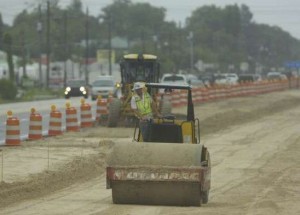We’ve mentioned it here before, but this year there is MAJOR construction on US-41 which has a major impact on business in the area as well as on the State Park.
How this all relates to Koreshan history goes back to the very beginning when the “Trail” was nothing more than that. In the intervening years the path has become part of a major highway that stretches from the east coast of Florida to the upper peninsula of Michigan.
In the 1920’s when the “Tamiami Trail” was completed, this created a source of income for the Koreshans who made money by opening the store which was about the only place for goods between Fort Myers and Naples.
US-41 has undergone any number of enlargements and enhancements. When expansion was done, construction came within a few feet of the “New Store” and necessitated the removal of the canopy and part of the facade of the building. In the 1970’s the area was put on the “National Register of Historic Places”, which made any infringement onto the land designated as “historic” forbidden. This complicated matters even more.
In 1979 a controversy grew when a group calling itself “The Committee for Four-laning U.S. 41 Along its Present Alignment”. The Naples Daily News wrote about in in 2009 in their “Thirty Years Ago This Week” column.
Citizens banded together 30 years ago to form an organization with a very long name and a specific mission: to get U.S. 41 four-laned through Estero along its existing route.
The non-partisan group of 15 people from Bonita Springs, Estero and San Carlos Park was named The Committee for Four-laning U.S. 41 Along its Present Alignment.
Members planned a multi-pronged assault that included a letter-writing campaign to officials, a petition drive, legal action and a call to oust a state official who was holding up the four-laning.
“This is one chance for all the people of this area to unite in something that concerns us all,’’ said Bonitan Walter Shikany.
The new group was determined to overturn state and federal rulings prohibiting the four-laning along the existing route, where right of way had already been purchased. The alignment glitch stemmed from the designation of the Koreshan settlement as a federal historic site, after the right of way was bought. The designation prohibited highway construction next to historic sites because of possible adverse affects. State and federal officials were recommending an alternate, westerly route that locals were against.
Committee member included Irv and Pearl Glucksman, Finis Burkhardt, Anthony Palone, Herbert Blakeman, Ruth Mason, Jo Harper, Minnie Cox, Vesper Egnew, many of whom were pictured recently in a Remember photo in The Banner.
Another meeting was planned for Feb. 26, 1979.
There was talk about routing US-41 to the east of the Historic Site and State government got involved with the widening becoming an issue in the election of the Florida Secretary of State.
Next month, we hope to have some articles from the “American Eagle” which highlight the controversy.
Suffice it to say, once again, the area is experiencing another change.
